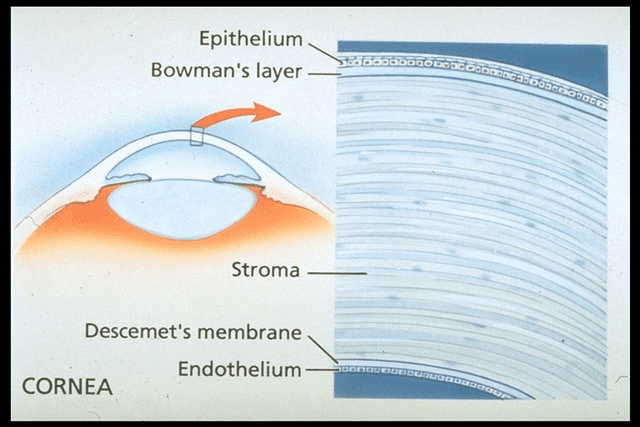 | *click the blue print in text to see video |
Epithelial Basement Membrane Dystrophy (EBMD)
The outermost layer (the “skin”) of the cornea is known as the epithelium. The epithelium needs to be tight and smooth to allow for crisp vision. In EBMD, the corneal epithelium is loose and does not adhere properly to the underlying corneal layer called Bowman’s layer. A good analogy in your home is having elevations of or bubbles underneath a glued floor because too little glue was applied to the foundation beneath.


Symptoms:
Many patients with mild EBMD have no symptoms. As the disease progresses it causes symptoms such as blurry or fluctuating vision, foreign body sensation, irritation, and redness. Patients may be misdiagnosed as simply having dry eye syndrome. In more severe cases, the corneal epithelium can become so loose that it spontaneously sloughs off in small pieces, known as a corneal erosion. This usually occurs when a patient wakes in the morning after their eyelid has been stuck to the surface of the cornea overnight and presents as severe eye pain, tearing, and blurry vision.
Cause:
Some patients have a genetic tendency for their corneal epithelium to become loose. EBMD is also frequently associated with an underdiagnosed skin condition called rosacea.
Diagnosis:
The earliest diagnosis is seen on screening topography which we perform routinely in our office. As EBMD progresses more it becomes more evident on examination.
Treatment:
For most patients, the use of frequent artificial tears is all that is needed to control symptoms. In cases of significant ocular discomfort, topical and oral anti-inflammatory medications may help. We also periodically apply soft protective bandage contact lenses and/or human amniotic membrane over the cornea. For patients having recurrent corneal erosions we suggest the use of a special eye ointment at bedtime for several months.
More advanced cases benefit from a procedure called superficial keratectomy where we remove the loose corneal epithelium and allow it to regrow smoothly under a bandage contact lens. We often smooth out Bowman’s layer with either a polishing tool or our in-office excimer laser (known as PTK) to improve adherence of the new corneal epithelium as it grows back. We are more frequently considering a superficial keratectomy in patients who have significant EBMD because it yields better retails after cataract surgery.
Should you need surgery, it will be performed at our state-of-the art ambulatory surgery center, Seashore Surgical Institute
Expertise:
Dr. Ragam is experienced in all facets of corneal surgery and has published research on corneal disease. We are fortunate on the Jersey shore to have such a talented and caring corneal specialist. We welcome Dr. Ragam to our multispecialty practice.
